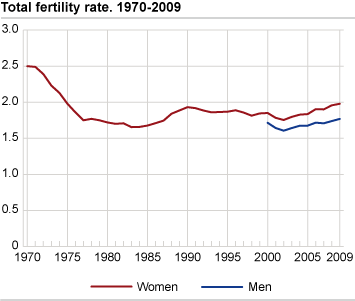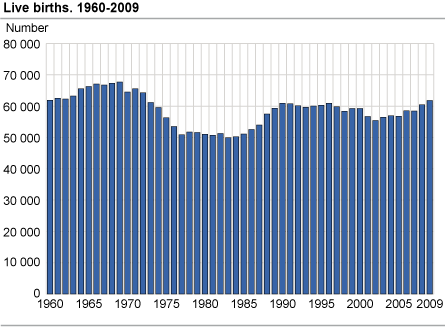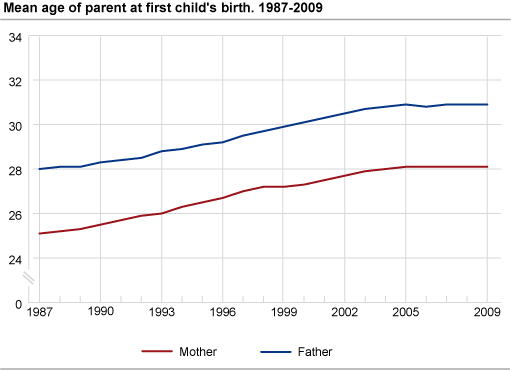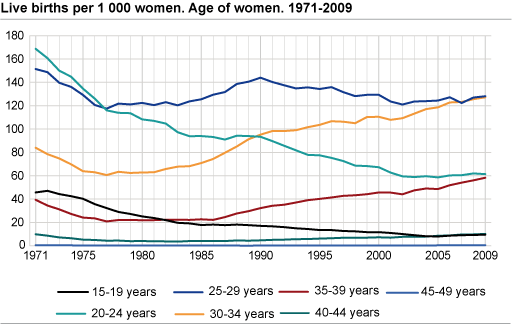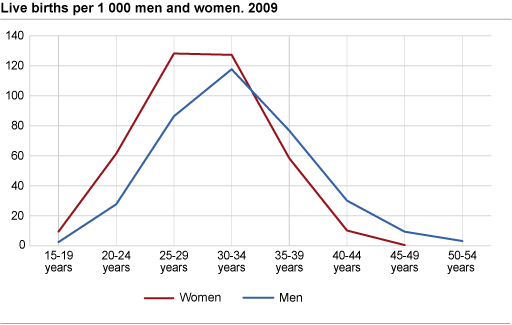Content
Published:
This is an archived release.
High fertility
A total of 61 800 children were born in Norway in 2009; an increase of 1 300 compared with 2008. Not since 1972 have more children been born in Norway than in 2009. The total fertility rate was 1.98 children per woman, which is among the highest in Europe.
The total fertility rate for women has increased during the last seven years, and in the period 2001-2005 the average was 1.80. The total fertility rate for men was 1.77 in 2009.
Highest fertility in the South-western part of the country
To ensure the reproduction of the population, i.e. where enough children are born to ensure that the population will not decrease in the long run, and excluding migration - the total fertility rate must be around 2.1. In 2009, six of the counties had a total fertility rate of 2.10 or more. The highest rates were in the counties of Rogaland with 2.18, Vest-Agder with 2.16, and Finnmark with 2.14. The counties of Telemark, Vestfold and Oppland had the lowest total fertility rates. Compared with 2008, the counties Østfold and Møre og Romsdal had the highest increase in the total fertility rate.
Parents’ mean age at birth of children stabilised
Over time, the mean age of parents at the birth of their children has increased, but has stabilised in recent years. The average age for women giving birth for the first time was slightly higher than 28 years in 2009, as it has been for recent years. The average age for men at their first child’s birth was 30.9 years in 2009, and it has varied between 30.8 and 30.9 years for the last six years.
Women aged 25-29 gave birth to most children
Women aged 25-29 and 30-34 had the highest fertility rates with 128.1 and 127.2 respectively per 1 000 women in 2009. The fertility rate increased for all age groups in the range 25-49 years compared with 2008. Most of the men becoming fathers in 2009 were in the age group 30-34 years.
Forty-four per cent of the children born in 2009 had married parents, 44 per cent had cohabitating parents and 12 per cent had a single mother. The highest percentages of children born by a single mother were in the counties of Finnmark (21 per cent), Hedmark (16) and Nordland (16). The lowest figures were in the counties of Rogaland and Akershus with 9 per cent each.
No changes in multiple births
In 2009 there were 1 057 twin births and 17 triple births, corresponding to 17.6 multiple births per 1 000 births. This is at the same level as in 2008.
Most children born in summer
Last year most children were born in June and fewest were born in December when we correct for the numbers of days per month. In earlier years, most of the children were born in April, but in recent years this has changed to most of the children being born in the summer months of June and July.
Total fertility rateThe total fertility rate (TFR) for women describes the average number of babies born alive per woman in the course of her reproductive period (15-49 years), under the presumption that the fertility pattern of the period lasts, and that deaths do not occur. Total fertility rate for men (TFR) is calculated for the age group 15-54 years. |
Tables:
- Table 1 Live births and late foetal deaths. 1951-2009
- Table 2 Confinements of single and multiple births, by sex. 1991-2009
- Table 3 Age-specific fertility rates and total fertility rate, women. 1961-2009
- Table 4 Average age of parent at child's birth. 1946-2009
- Table 5 Age-specific fertility rates and total fertility rate, men. 2000-2009
- Table 6 Total fertility rate, women, by county. 1968-2009
- Table 7 Live births, by parity. 1978-2009
- Table 8 Live births, by parity, cohabitation status of mother and county. 2009
- Table 9 Number of children distributed, by age and cohort . Per cent
Contact
-
Statistics Norway's Information Centre
E-mail: informasjon@ssb.no
tel.: (+47) 21 09 46 42
-
Espen Andersen
E-mail: espen.andersen@ssb.no
tel.: (+47) 92 61 00 46
-
Ane Margrete Tømmerås
E-mail: ane.tommeras@ssb.no
tel.: (+47) 91 99 29 62
-
Oppdrag befolkningsstatistikk
E-mail: befolkning@ssb.no

